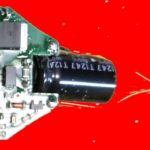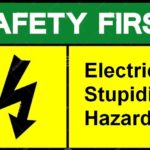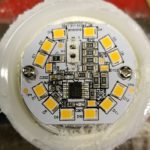It pays to know the limitations and strengths of widely used methods of measuring current.
Sam Locke • Allegro Microsystems
Recent technological developments such as fast dc charging for electric vehicles and high-power processing in data centers drive the quest for delivering more power in smaller spaces. Congruent with that quest is the need for high efficiency to minimize wasted power.
AC/DC power supplies, switching dc/dc converters, and dc/ac inverters that implement power factor correction are all power conversion systems that use current feedback to regulate properly and efficiently. Thus designers of such systems must understand current sensing and how it plays into overall system design and performance. There are various current sensing methods in power delivery, all with their own advantages.
Some power conversion controllers have integrated current sensing, usually via an on-board amplifier connected to an external shunt. While this approach is relatively simple, many integrated solutions are optimized for a specific application and don’t adapt well to others. Consequently, many topologies instead use a generic microcontroller and external current sensing to send information back to the controller. Besides the traditional current sense amplifier and shunt, approaches to current sensing typically seen in power conversion systems include the use of an isolated amplifier and shunt, and Hall-effect current sensors.
 Traditional shunt approaches can be economical, but demands for high accuracy can boost the cost of the shunt. Shunts also offer superior accuracy at low currents (<2 A) compared to magnetic sensing.
Traditional shunt approaches can be economical, but demands for high accuracy can boost the cost of the shunt. Shunts also offer superior accuracy at low currents (<2 A) compared to magnetic sensing.
Current-sense amplifiers are often limited by their common-mode voltage range. Common-mode voltage is the average voltage between the inputs of the current-sense amplifier and usually ranges from -10 V up to +100 V. Traditional amplifiers cannot handle the negative voltage of an ac source. The +100 V maximum also limits the use of traditional amplifiers in high-voltage dc applications unless the sensor is close to ground. But a sensor with one terminal close to ground eliminates the ability to detect a short and creates a voltage drop from system ground and actual ground. Use of isolated amplifiers removes the limitation of sensing negative and high positive voltages but at the expense of reduced bandwidth, the need for an isolated supply, more PCB space, and higher cost.
One drawback to any shunt approach is the dependence on shunt parameters such as tolerance, temperature drift, and parasitic inductance. All these factors affect overall system accuracy and performance. At high switching speeds common in power conversion, shunt inductance boosts the overall shunt impedance. As frequency rises, so does the shunt impedance which will reduce the overall system accuracy and speed as well as cause output spikes.

Hall-effect current sensing measures the voltage (VHALL) across a biased Hall plate created by the magnetic field (B) of a current-carrying (I) wire. Hall-based approaches have the benefit of inherent galvanic isolation and working voltages up to >1,000 V. This property lets them find use in ac and dc high-voltage applications without the need for a secondary isolated supply.
Internal conductor Hall sensors are highly integrated and require no external shunt, facilitating their use in tight layout designs. Additionally, because sensing takes place magnetically, the conductor inductance doesn’t affect the sensor output, especially helpful for mitigating output spikes when the current switches on and off. Another benefit is that the internal conductor has a low resistance. This low resistance gives the Hall-based approaches power losses lower than those of shunt-based approaches and an advantage at higher current levels.
Power factor correction
Power factor correction (PFC) applied to ac-to-dc conversion aims to reduce the reactive power required from the utility and improve overall efficiency. In ac systems,

inductive loads such as motors, coils, or transformers can cause the current to become out of phase with the voltage. This creates reactive power that is generated but does no actual work. Reducing reactive power boosts overall system efficiency.
There are many PFC topologies including passive filtering techniques, boost PFC, dual boost bridgeless PFC, and totem-pole bridgeless PFC. As efficiency requirements rise, so too does complexity and cost. Totem-pole topologies are becoming widely used because of their high efficiency, in some cases reaching above 99%.
All active PFC topologies require sensing of the input current and voltage to regulate output and reduce phase separation. The high line voltage requires an isolated approach such as the Hall-based or an isolated amplifier. Switching speeds of PFC circuits are kept high to reduce power loss, typically from 50 to 100 kHz. Current sensor bandwidth is typically two to ten times faster than the switching speed to allow for adequate feedback. This requirement implies a 100 kHz to 1 MHz current sensor bandwidth. Isolated current-sense amplifier circuits are typically limited to 300 kHz while Hall solutions can reach up to 1 MHz.
Electronic circuits run on a wide range of dc voltages, hence the need for dc-to-dc conversion either on the ac/dc output or for systems with multiple dc rails. DC/DC topologies include but are not limited to the buck, boost, buck-boost, flyback, and resonant.

A resonant topology has the advantage of compact size, high power density, and galvanic isolation. These qualities earn it wide use in EV charging and energy storage. Hall-based current sensing is particularly advantageous in high-voltage dc topologies with high-isolation requirements (>100 V). Switching frequencies and bandwidth requirements for dc/dc resemble those of PFC topologies, 100 kHz to 1 MHz.
Inverters take a dc voltage and transform it into an ac voltage. Inverters fined use when dc sources such as solar arrays or batteries feed power into the grid or for powering large ac motors. Inverters typically have relatively low switching speeds (often a few kilohertz to a few megahertz) and consequently require less bandwidth.
Non-isolated current sensing, such as traditional current-sense amplifiers with shunts, can work in inverters, but the sensor must sit next to ground instead of in-phase with the ac output. This configuration limits the ability to detect output shorts and creates a voltage drop from system ground and actual ground. This low-side sensor placement can only sense current when the low-side switch is on.
In-phase isolated amplifiers or Hall-based approaches eliminate the ground difference, enable short detection, and can sense current regardless of switching state. This same concept can be applied to current sensor placement in motor control.







Leave a Reply